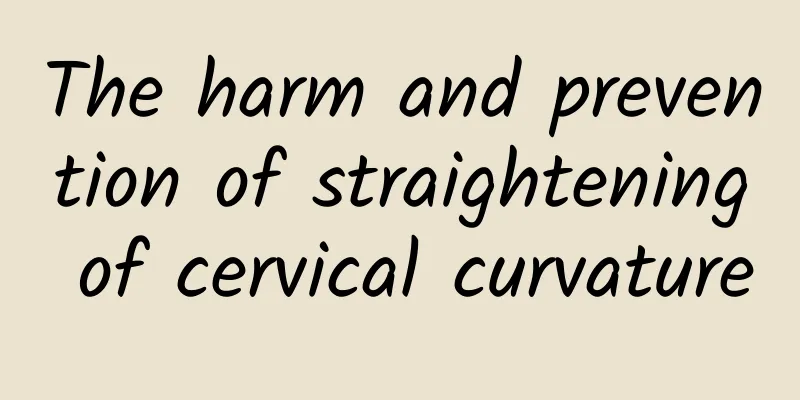The harm and prevention of straightening of cervical curvature

|
If you have ever had headaches, dizziness, neck discomfort, or numbness in your arms, it may be that there is a problem with your cervical spine. Go to the rehabilitation medicine department and take an X-ray. Most people’s imaging reports will say the same thing: the cervical curvature has become straightened! | What is cervical curvature straightening The normal cervical spine has a forward bulge, which is a "C"-shaped structure, which is the basis of its mechanical structure. This "C"-shaped physiological arc ensures the high flexibility and stability of the cervical spine, so that the 7 small bones that make up the cervical spine can bear the weight of the entire head and complete various movements. The curvature of the cervical spine is formed by the thick front and thin back of the C4-C5 intervertebral disc, which is also the need of the physiological structure and function of the human body, and will not cause the cervical disc to protrude. However, when the curvature of the cervical spine becomes straight or even the cervical spine is arched due to various reasons, this perfect arc no longer exists. At this time, the cervical spine no longer has the ability to bear the weight of the head, no longer can buffer pressure, and no longer has the structure of the C4 and C5 intervertebral discs that are thick in front and thin in the back, etc., so the cervical spine will undergo degenerative changes and cervical disc protrusion, causing clinical symptoms and signs such as pain, dizziness, and numbness. It can be seen that the necessity of the physiological curvature exists. | What mechanical changes occur when the cervical curvature becomes straight? The normal physiological curvature of our cervical spine is about 15° to 22° for men and about 15° to 25° for women, with an average of about 20°. No matter what position we are in, when we look straight ahead, the center of gravity of the head falls right in the middle of the body, and the load on our cervical spine is about 5kg. Every 15 degrees of lowering the head will increase the weight by 5-7kg. When we look at mobile phones, computers, IPADs, or drive private cars with our heads lowered by 60°, the load on the cervical spine can even reach 27kg. What is the concept of 27kg? A disc in our Olympic weightlifting is 25kg, which is equivalent to wearing a barbell while working. In the long run, we will eventually lower our noble heads. The convex cervical spine is like a perfect bow, and the muscles, ligaments, intervertebral discs and other soft tissues that maintain the curvature of the cervical spine are like a taut bowstring. The combined effect of these structures maintains the stability of the mechanical structure of the cervical spine and the patency of the nerve ducts. When we bend over our desks and bow our heads for a long time, the center of gravity moves forward and the torque is lengthened, which causes fatigue of the soft tissues and causes pain and discomfort. Over time, just like a rubber band that has been stretched for a long time, it eventually loses its elasticity and the ability to maintain the normal curvature of the cervical spine. This leads to a vicious cycle, which is what we often call cervical degeneration. Vertebra degeneration can lead to disc herniation, osteophyte formation, ligament hypertrophy, etc., which squeezes important structures such as the spinal cord, nerves, and blood vessels, and causes various clinical symptoms such as limb numbness and abnormal sensory function. | What adverse symptoms may occur when the cervical curvature becomes straight? When the cervical curvature becomes straight, a series of changes will occur in the joints, muscles, ligaments, fascia, blood vessels, etc. around the cervical spine. These changes will become the structural and pathological basis for various cervical spondylosis such as ligament hyperplasia, calcification, cervical disc herniation, vertebral artery stenosis, etc. Eventually, our cervical spine will be overwhelmed and more new problems will appear, causing various types of cervical spondylosis. (1) Cervical spondylosis: The cervical curvature becomes straightened, accompanied by changes in soft tissues such as muscles and fascia. You will feel symptoms such as neck and shoulder stiffness, pain, discomfort, and headache. (2) Vertebral artery type cervical spondylosis: The straightening of the cervical curve will cause compression of the vertebral artery, resulting in insufficient blood supply to the brain, making people prone to fatigue, dizziness, headache, nausea and vomiting. (3) Sympathetic cervical spondylosis: The straightening of the cervical curve will cause the corresponding facet joints and uncovertebral joints to proliferate, compressing the cervical sympathetic nerves and causing related symptoms such as palpitations and sweating. (4) Radiculopathy: The straightening of the cervical curve and changes in the muscles can compress the related nerve roots, causing numbness and pain in the limbs. (5) Spinal cervical spondylosis: The straightening of the cervical curvature can cause corresponding cervical disc herniation, bone hyperplasia, and hypertrophy of the yellow ligament, which can cause spinal canal stenosis and compression of the spinal cord, resulting in intermittent claudication, a feeling of walking on cotton, and other related clinical symptoms and manifestations. | What are the self-rehabilitation training methods for cervical spondylosis? If you want your cervical spine to last a few more years, you must do the following three things: first, the correct posture, second, a suitable pillow, and third, self-rehabilitation cervical exercises. (1) The first is posture: When we work and play, we should try to keep our bodies upright and look forward. Good posture is important for maintaining a good cervical curvature. By adjusting our working environment, we can significantly reduce the risk of cervical diseases. Adjust the height of the workbench, desk and chair so that the monitor is at eye level; use a chair with armrests to support the arms, and use a footstool when necessary; the knees should be slightly lower than the hips when sitting. At the same time, when using a mobile phone, moving the hand position upward can keep the neck in a neutral position, thereby effectively reducing the pressure of the head on the cervical spine. Of course, we should also avoid reading, playing with mobile phones or watching TV in the "Ge You lying" posture. Because even if we are lying down, we are still in a posture with our heads down and bent, which can still cause continuous damage to the cervical spine. (2) Choose a suitable pillow: The muscles around our cervical spine work against gravity every day to maintain the stability of the cervical spine. If our pillow is not properly placed at night, the area under the neck is empty and the cervical spine is still working against gravity like a bow. Therefore, the neck cannot rest for 365 days. Over time, strain will occur and the cervical spine will lose stability, which will cause corresponding symptoms and signs. As the saying goes, "a high pillow brings peace of mind", but in fact, both high and low pillows are worrying. From a medical point of view, the cervical curve is convex to the front. If the pillow is too high, it will cause excessive flexion of the neck, the physiological curvature will become straight, and the muscles and ligaments at the back of the cervical spine will be in a state of continuous traction and tension; if the pillow is too low, the neck will be suspended in the air and the lower jaw will be raised, which will make it easy to breathe with the mouth open and snore. The deep muscles in the front of the cervical spine need to be contracted to maintain, and the small facet joints at the back will also be continuously squeezed. Therefore, pillows that are too high or too low will cause clinical symptoms. Therefore, when choosing a pillow, you need to pay attention to three factors: ① Curvature: A scientific pillow has a groove design or can be adjusted into a groove shape, and the middle is lower than the surrounding; ② Height: For adults, the height of the pillow is 5-10 cm when lying on your back, and about 10-15 cm when sleeping on your side; ③ Material: The selected pillow should have a certain degree of breathability and heat dissipation effect. Buckwheat husks left by our ancestors are the best material! Some people use harder materials such as harder bottles and wooden rollers, which will affect blood circulation and are not advisable! | Self-rehabilitation cervical spine exercises In addition to surgery and drug treatment, among all conservative treatment measures, reasonable and moderate exercise can enhance muscle strength and flexibility to ensure the stability of the cervical spine. We can compare the cervical spine to a bundle of firewood. The vertebrae of the cervical spine are equivalent to firewood sticks, and the rope that ties the firewood is equivalent to our muscles, tendons and ligaments. In the middle of the firewood are blood vessels and nerves. When the rope is loose, the firewood will scatter, and the nerves and blood vessels will be displaced. Nerve displacement will cause numbness and pain, and blood vessel displacement will cause dizziness, nausea, and vomiting. So in order to return the blood vessels and nerves to their original positions, we must tighten the rope. In other words, we need to strengthen the core muscle strength training around the neck to increase the stability of the cervical spine, so that the clinical symptoms will disappear when the nerves and blood vessels are returned to their original positions! In addition, we have designed cervical spine exercises to ensure the stability of the cervical spine and reduce the occurrence of clinical symptoms. We hope that everyone can use their arms to hold the front, back and sides of the head with their bare hands to perform resistance training of neck flexion, extension, left and right lateral flexion and left and right rotation during work breaks to improve muscle strength and neck stability. Elastic bands and elastic balls can also be used for static resistance training. Exercise in each direction lasts for 5 seconds, rest for 5 seconds, and then proceed to exercise in the next direction. It takes about one minute to complete exercise in six directions, one minute for one set. You can do 5 sets each time, 3-4 times a day, and rest for 1 minute between sets. |
<<: BlackBaud & Charity Dynamics: How to use social media to raise funds?
>>: Enterbrain: Japan's social game market size reached $1.45 billion in 2010
Recommend
My period is dark and lasts longer.
The blood discharged by women during menstruation...
Which university graduates can enter Huawei? How to choose a major if you want to work at Huawei after graduating from university?
For many students, Huawei is the pride of China, ...
What kind of exercise can girls do to grow taller?
A beautiful lady is a gentleman's dream. Tall...
Master these kidney health tips to make your kidneys healthier
There are many people who neglect kidney health, ...
What causes enlarged ovaries?
If the ovaries are enlarged, they must be diagnos...
How to recover quickly after childbirth
Many women are afraid of having children. They th...
What is Wasabi? Benefits of Wasabi
Wasabi is a perennial herb and a special health-c...
What to expect after a cervical biopsy
Cervical biopsy is a common medical method. This ...
Bright red menstrual blood is not normal
Women are more prone to physical problems during ...
What is the cause of female blood in urine and how to solve it
Some women will find blood in their urine when go...
How long is the best time to do Down syndrome screening during pregnancy?
Everyone hopes that their baby can be healthy, bu...
Do you need to wipe after urinating?
Many women are accustomed to wiping with toilet p...
What kind of sleeping bag should I buy for my baby? What should I pay attention to when buying a good baby sleeping bag?
In order to prevent their children from getting c...
Why is the vaginal discharge yellow-green?
Normal leucorrhea should be colorless and odorles...









